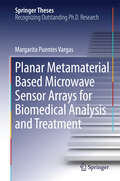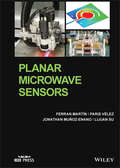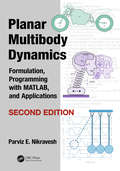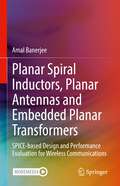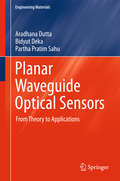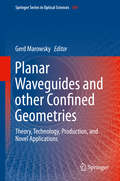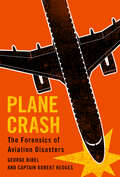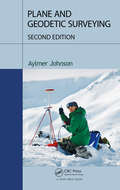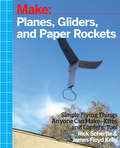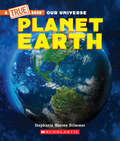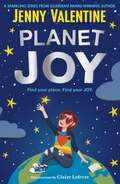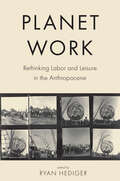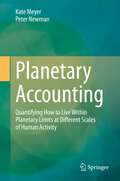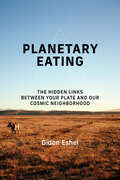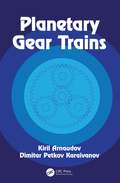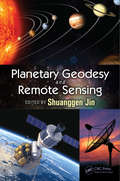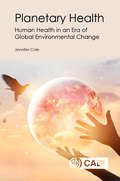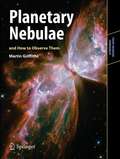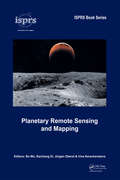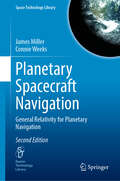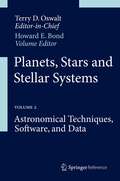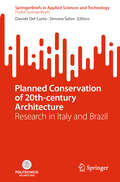- Table View
- List View
Planar Metamaterial Based Microwave Sensor Arrays for Biomedical Analysis and Treatment
by Margarita Puentes VargasThis book presents an innovative concept for the realization of sensors based on a planar metamaterial microwave array and shows their application in biomedical analysis and treatment. The sensors are able to transduce the dielectric properties of materials in their direct vicinity into an electric signal. The specific array organization permits a simultaneous analysis of several materials using a single readout signal or a relative characterization of one material where information about its spatial distribution can be extracted. Two applications of the designed sensors are described here: the first is a cytological screening using micro fluidic technology, which shows that the sensors may be integrated into lab-on-chip technologies; the second application regards the use of the sensor in both the analysis and treatment of organic tissues. The developed sensor is able not only to screen the tissues for abnormalities, but also, by changing the applied signals, to perform thermal ablation and treat the abnormalities in a highly focused way. Thus, the research described in this book represents a considerable advancement in the field of biomedical microwave sensing.
Planar Microwave Engineering: A Practical Guide to Theory, Measurement, and Circuits
by Thomas H. LeeModern wireless communications hardware is underpinned by RF and microwave design techniques. This insightful book contains a wealth of circuit layouts, design tips, and practical measurement techniques for building and testing practical gigahertz systems. The book covers everything you need to know to design, build, and test a high-frequency circuit. Microstrip components are discussed, including tricks for extracting good performance from cheap materials. Connectors and cables are also described, as are discrete passive components, antennas, low-noise amplifiers, oscillators, and frequency synthesizers. Practical measurement techniques are presented in detail, including the use of network analyzers, sampling oscilloscopes, spectrum analyzers, and noise figure meters. Throughout the focus is practical, and many worked examples and design projects are included. There is also a CD-ROM that contains a variety of design and analysis programs. The book is packed with indispensable information for students taking courses on RF or microwave circuits and for practicing engineers.
Planar Microwave Sensors (IEEE Press)
by Ferran Martín Paris Vélez Jonathan Muñoz-Enano Lijuan SuComprehensive resource detailing the latest advances in microwave and wireless sensors implemented in planar technology Planar Microwave Sensors is an authoritative resource on the subject, discussing the main relevant sensing strategies, working principles, and applications on the basis of the authors’ own experience and background, while also highlighting the most relevant contributions to the topic reported by international research groups. The authors provide an overview of planar microwave sensors grouped by chapters according to their working principle. In each chapter, the working principle is explained in detail and the specific sensor design strategies are discussed, including validation examples at both simulation and experimental level. The most suited applications in each case are also reported. The necessary theory and analysis for sensor design are further provided, with special emphasis on performance improvement (i.e., sensitivity and resolution optimization, dynamic range, etc.). Lastly, the work covers a number of applications, from material characterization to biosensing, including motion control sensors, microfluidic sensors, industrial sensors, and more. Sample topics covered in the work include: Non-resonant and resonant sensors, reflective-mode and transmission-mode sensors, single-ended and differential sensors, and contact and contactless sensors Design guidelines for sensor performance optimization and analytical methods to retrieve the variables of interest from the measured sensor responses Radiofrequency identification (RFID) sensor types, prospective applications, and materials/technologies towards “green sensors” implementation Comparisons between different technologies for sensing and the advantages and limitations of microwave sensors, particularly planar sensors Engineers and qualified professionals involved in sensor technologies, along with undergraduate and graduate students in related programs of study, can harness the valuable information inside Planar Microwave Sensors to gain complete foundational knowledge on the subject and stay up to date on the latest research and developments in the field.
Planar Multibody Dynamics: Formulation, Programming with MATLAB®, and Applications, Second Edition
by Parviz E. NikraveshPlanar Multibody Dynamics: Formulation, Programming with MATLAB®, and Applications, Second Edition, provides sets of methodologies for analyzing the dynamics of mechanical systems, such as mechanisms and machineries, with coverage of both classical and modern principles. Using clear and concise language, the text introduces fundamental theories, computational methods, and program development for analyzing simple to complex systems. MATLAB is used throughout, with examples beginning with basic commands before introducing students to more advanced programming techniques. The simple programs developed in each chapter come together to form complete programs for different types of analysis.
Planar Spiral Inductors, Planar Antennas and Embedded Planar Transformers: SPICE-based Design and Performance Evaluation for Wireless Communications
by Amal BanerjeeThis book presents a novel, automated, accurate and unified scheme to design and determine the performance characteristics of standalone planar, spiral inductors and multiple coupled planar spiral inductors (as in embedded transformers), for RF/microwave MMIC designers. The author demonstrates with a set of analysis/design examples a novel scheme that exploits judiciously the existing transmission theory and concepts, organizing and condensing available, scattered information/knowledge about planar spiral inductor, embedded planar transformer and planar antenna design and performance evaluation, into one coherent and unified electronic circuit model easily used by radio frequency electronic circuit engineers. A dedicated chapter contains an exhaustive (19) set of design examples.Presents a bottom-up scheme, starting with Maxwell's equations of classical electrodynamics and transmission line theory (Telegrapher's equation), specifically microstrips;Demonstrates design of standalone planar, spiral inductors and multiple coupled planar spiral inductors;Includes a set of ready-to-use, C executables (for both Linux and Windows) , that accept predefined input parameters for each of the sub-circuits discussed and generate SPICE netlists for the equivalent electrical circuit;Automates execution of multi-step design calculations to guarantee their accuracy and reliability.
Planar Waveguide Optical Sensors
by Aradhana Dutta Bidyut Deka Partha Pratim SahuThis book concentrates on the design and development of integrated optic waveguide sensors using silicon based materials. The implementation of such system as a tool for detecting adulteration in petroleum based products as well as its use for detection of glucose level in diabetes are highlighted. The first chapters are dedicated to the development of the theoretical model while the final chapters are focused on the different applications of such sensors. It gives the readers the full background in the field of sensors, reasons for using silicon oxynitride as a potential waveguide material as well as its fabrication processes and possible uses.
Planar Waveguides and other Confined Geometries
by Gerd MarowskyThis book provides a comprehensive overview of the theoretical concepts and experimental applications of planar waveguides and other confined geometries, such as optical fibres Covering a broad array of advanced topics, it begins with a sophisticated discussion of planar waveguide theory, and covers subjects including efficient production of planar waveguides, materials selection, nonlinear effects, and applications including species analytics down to single-molecule identification, and thermo-optical switching using planar waveguides Written by specialists in the techniques and applications covered, this book will be a useful resource for advanced graduate students and researchers studying planar waveguides and optical fibers.
Plane Crash: The Forensics of Aviation Disasters
by George Bibel Captain Robert HedgesMelding a pilot’s practical view of life in the cockpit with the expertise of an engineering professor to give readers an insider look at plane crashes.One of the most amazing feats of modern life is the frequency with which airplanes safely take off and land: about 40,000 times a day in the United States alone. Commercial aviation is by far the safest mode of transportation and is becoming safer all the time. But on the exceedingly rare occasion that a plane does crash, comprehensive accident analysis, thorough investigation, and implementation of remedial actions significantly reduces the probability of an already remote event ever recurring.Plane Crash, an unprecedented collaboration between mechanical engineering professor George Bibel and airline Captain Robert Hedges, shares the riveting stories of both high-profile and lesser-known airplane accidents. Drawing on accident reports, eyewitness accounts, and simple diagrams to explain what went wrong in the plane and in the cockpit, Hedges provides invaluable insight into aviation human factors, while Bibel analyzes mechanical failures. No prior scientific knowledge is needed to understand the principles and procedures this book describes, only an interest in the view from what Captain Hedges describes as "the best seat in the house."Organized around the phases of flight—takeoff, climb, cruise, approach, and landing—this book is a captivating look at some of the most dramatic plane crashes of the modern age, including Asiana Airlines 214, Air France 447, and Malaysia Airlines 370. If you have ever wondered what goes through a pilot’s mind as a flight takes a turn for the dangerous, what impact turbulence actually has on flight safety, or even just how the wonders of aeronautics work to keep passengers safe day in and out, Plane Crash will both fascinate and educate.
Plane Finite Elements for Two-Dimensional Problems: Application of the Computer Algebra System Maxima
by Andreas Öchsner Resam MakvandiThis book is intended as a study aid for the finite element method. Based on the free computer algebra system Maxima, we offer routines to symbolically or numerically solve problems from the context of two-dimensional problems. For this rather advanced topic, classical ‘hand calculations’ are difficult to perform and the incorporation of a computer algebra system is a convenient approach to handle, for example, larger matrix operations. The mechanical theories focus on the classical two-dimensional structural elements, i.e., plane elements, thin or classical plates, and thick or shear deformable plate elements. The use of a computer algebra system and the incorporated functions, e.g., for matrix operations, allows to focus more on the methodology of the finite element method and not on standard procedures. Furthermore, we offer a graphical user interface (GUI) to facilitate the model definition. Thus, the user may enter the required definitions in a source code manner directly in wxMaxima or use the GUI which is able to execute wxMaxime to perform the calculations.
Plane and Geodetic Surveying
by Aylmer JohnsonPlane and Geodetic Surveying blends together theory and practice, conventional techniques and satellite-based methods, to provide the ideal book for students of surveying. It gives detailed guidance on how and when the principal surveying instruments (total stations, levels and navigational satellite receivers) should be used. It fully and clearly
Planen mit Tageslicht: Grundlagen für die Praxis (essentials)
by Renate Hammer Mathias WambsganßNeue Erkenntnisse zur Wichtigkeit ausreichender Tageslichtversorgung im Innenraum haben planungsrelevante Änderungen normativer Vorgaben nach sich gezogen. Renate Hammer und Mathias Wambsganß veranschaulichen die neuen Anforderungen und erläutern die Möglichkeiten zur planerischen Umsetzung. Die Autoren klären, wann Tageslichtversorgung und Besonnung als ausreichend gelten, welche Qualitäten die Sichtverbindung nach außen erfüllen muss und wie Blendung durch Tageslicht zu begrenzen ist. Angaben zur melanopischen Wirkungsweise von Tageslicht bieten einen Einstieg in den planerischen Umgang mit nicht-visuellen Kriterien. Ein weiteres Kapitel zeigt die Schnittstellen mit anderen Aspekten der Bauplanung.Die Autoren:Dr. Renate Hammer studierte Architektur, Solararchitektur und Philosophie in Wien und Krems sowie Urban Engineering in Tokio. 2015 gründete sie das Institute of Building Research & Innovation. Sie unterrichtet einschlägig an der Kunstuniversität Linz und der FH Campus Wien. Prof. Mathias Wambsganß studierte Architektur an der Universität Karlsruhe (TH). 2014 gründete er das Büro „3lpi lichtplaner“ in München. Er ist langjähriges Mitglied im Vorstand der LiTG e.V. und wurde 2007 als Professor an die TH Rosenheim berufen.
Planes, Gliders and Paper Rockets: Simple Flying Things Anyone Can Make--Kites and Copters, Too!
by James Floyd Kelly Rick SchertleDo helicopters need more or less energy to stay in the sky than an airplane? What pushes a rocket to leave the atmosphere? Why can airplanes have smaller motors than helicopters? Help your students learn the answers to these and other questions! Written for educators, homeschoolers, parents--and kids!--this fully illustrated book provides a fun mix of projects, discussion materials, instructions, and subjects for deeper investigation around the basics of homemade flying objects. With the projects in this book, you can spend more time learning and experimenting, and less time planning and preparing. Complete with download links to PDF templates that expand your teaching, this is your one-stop manual for learning about, interacting with, and being curious about airflow, gravity, torque, power, ballistics, pressure, and force. In Make: Planes, Gliders, and Paper Rockets, you'll make and experiment with: Paper catapult helicopter--add an LED light for night launches!Pull-string stick helicopterRubber band airplaneSimple sled kite25-cent quick-build kiteAir rockets with a parachute or a gliderFoam air rocketRocket standsBounce rocketLow- and high-pressure rocket launchers
Planet Earth (A True Book (Relaunch))
by Stephanie Warren DrimmerDiscover the wonder and learn the truth about our rocky home.Why does life exist on Earth but nowhere else in our solar system? What causes Earth's seasons? What makes up the Earth's interior? This book answers these questions and many more about our rocky home. From Earth's place in space, to its atmosphere and time zones, everything readers need to know about planet Earth is covered!Planets and stars, moons and galaxies! The universe is a vast and mysterious place with much to explore. And there's no better way to make amazing discoveries about space than with this reimagined series. With the latest NASA imagery, the classic structure and features of A True Book, and lively text, the titles in Our Universe bring the awe of the cosmos directly to readers. Students will come away with a wealth of knowledge about the incredible celestial bodies in our universe.This series covers Next Generation Science Standards core ideas including "The Universe and its stars" and "Earth and the solar system."
Planet Joy
by Jenny ValentineFor readers aged 9+ comes the third book in a sparkling series about family, friends and finding the joy in life! From Guardian award-winning author Jenny Valentine, this is the perfect series for fans of Jacqueline Wilson, Cath Howe and Lara Williamson! Meet ten-year-old Joy Applebloom, a girl with a knack for finding the silver lining in even the darkest of rainclouds. After years of travelling the world with her family, Joy feels like she&’s finally found a place she can call home. She&’s settled in at school, has a new best friend called Benny and she&’s finally making a difference in the world. But when a new girl, Phoebe Dark, joins class 6C, Joy discovers there&’s a whole world out there that she hasn&’t explored yet . . . Could Plane Tree Gardens be just the beginning?A heart-warming and joyful series about family, friends and never being too small to make a difference, with gorgeous illustrations from Claire Lefevre. 'A delight for its warmth and humour, but principally because the writing is alive and stunning' The Sunday Times on A Girl Called Joy
Planet Work: Rethinking Labor and Leisure in the Anthropocene
by James Armstrong Jennifer K. Ladino Amanda Adams Ted Geier Sharon O'Dair Ryan Hediger David Rodland Sinan Akilli Daniel Clausen Matt Wanat Will Elliot Kevin Maier Jo ReyLabor and labor norms orient much of contemporary life, organizing our days and years and driving planetary environmental change. Yet, labor, as a foundational set of values and practices, has not been sufficiently interrogated in the context of the environmental humanities for its profound role in climate change and other crises. This collection of essays demonstrates the urgent need to rethink models and customs of labor and leisure in the Anthropocene. Recognizing the grave traumas and hazards plaguing planet Earth, contributors expose fundamental flaws in ideas of work and search for ways to redirect cultures toward more sustainable modes of life. These essays evaluate Anthropocene frames of interpretation, dramatize problems and potentials in regimes of labor, and explore leisure practices such as walking and storytelling as modes of recasting life, while a coda advocates reviving notions of work as craft.
Planetary Accounting: Quantifying How to Live Within Planetary Limits at Different Scales of Human Activity
by Peter Newman Kate MeyerThis book presents a novel way to enable people, regardless of their scale of influence, to take responsibility for global environmental problems including climate change. It introduces a new framework called Planetary Accounting, which allows the Planetary Boundaries, non-negotiable limits for the environment, to be translated into limits for human activity. It shows how such limits can be broken down into chunks that can be managed at different levels (from individual and community, to business and sector levels, to cities and regions), and at any level of government. The book begins by summarising the science of climate change and introducing the notion of the Anthropocene – the “human age”. It highlights the importance of returning to and remaining within the Planetary Boundaries but shows that we can’t realistically do so unless we have a new approach to environmental accounting.The book then outlines how Planetary Accounting furnishes this new approach by combining sustainability science, change theory, and environmental accounting to create a scalable framework for environmental management that encourages systemic and individual change. The details of the science of and our human contribution to ten critical human pressures are then presented, and the book concludes with a guide for those seeking to apply Planetary Accounting in practice. Planetary Accounting could form the scientific underpinning of behaviour change programs, guide the development of policy and regulations, and provide both the basis for environmental laws, and the foundation of future global environmental agreements. It has been 50 years since the first views from space showed a blue planet alone in our solar system. This book is an historic opportunity to provide humanity for the first time with sufficient information to begin implementing Planetary Accounting.
Planetary Eating: The Hidden Links between Your Plate and Our Cosmic Neighborhood
by Gidon EshelA scientifically rigorous guide to making the best dietary choices for both our personal health and our environmental footprint.Many of us try our best to eat foods that are healthy and environmentally sustainable. But are we getting it right? Which foods amount to &“wise&” choices, and which ones are best avoided? Common views often range widely and are sometimes even contradictory. It&’s most unfortunate when conscientious individuals who go to great lengths in their quest to minimize environmental impacts follow the wrong advice. In Planetary Eating, Gidon Eshel aims to minimize such misuse of good will by providing scientifically untrained readers with the tools needed to make the best choices for themselves and for our planet.Eshel writes that dietary choices, and the corresponding agricultural patterns, are, for most of us, our principal form of planetary agency—the main ways by which we impact our overburdened and undernourished host planet. Agriculture and diet are therefore most productively examined through the planetary science perspective. Starting from rather basic (but not quite first) principles, Planetary Eating offers impartial, fact-based analysis with firm foundations in earth and planetary sciences on how to make the right dietary choices.
Planetary Gear Trains
by Kiril Arnaudov Dimitar Petkov KaraivanovThis book provides comprehensive information for various planetary gear trains, with practical applications and comprehensive references to technical articles. In the text's chapters, readers can find all the information needed for various types of gear trains, with illustrations and examples. The authors help gear designers to creatively understand the design of gears, as well as master the mechanical calculations needed. Planetary Gear Trains is the most comprehensive and up-to-date work available in this key technical area. <P><P>The book reflects not only teaching, but also the practical experience of the authors. It was developed under the motto "From practice to practice".
Planetary Geodesy and Remote Sensing
by Shuanggen JinAlthough lunar exploration began in the 1960s, the moon and other planets have many long-standing, unanswered questions about planetary environments, origin, formation and evolution, magnetization of crustal rocks, internal structure, and possible life. However, with the recent development of planetary geodesy and remote sensing with higher spatial
Planetary Health: Human Health in an Era of Global Environmental Change
by Jennifer ColePlanetary Health - the idea that human health and the health of the environment are inextricably linked - encourages the preservation and sustainability of natural systems for the benefit of human health. Drawing from disciplines such as public health, environmental science, evolutionary anthropology, welfare economics, geography, policy and organizational theory, it addresses the challenges of the modern world, where human health and well-being is threatened by increasing pollution and climate change. A comprehensive publication covering key concepts in this emerging field, Planetary Health reviews ideas and approaches to the subject such as natural capital, ecological resilience, evolutionary biology, One Earth and transhumanism. It also sets out through case study chapters the main links between human health and environmental change, covering: - Climate change, land use and waterborne infectious diseases. - Sanitation, clean energy and fertilizer use. - Trees, well-being and urban greening. - Livestock, antibiotics and greenhouse gas emissions. Providing an extensive overview of key theories and literature for academics and practitioners who are new to the field, this engaging and informative read also offers an important resource for students of a diverse range of subjects, including environmental sciences, animal sciences, geography and health.
Planetary Nebulae and How to Observe Them
by Martin GriffithsPlanetary Nebulae and How to Observe Them is for amateur astronomers who want to go beyond the Messier objects, concentrating on one of the most beautiful classes of astronomical objects in the sky. Planetary nebulae are not visible to the naked eye, but they are a fascinating group of telescope objects. This guide enables a user equipped with an average-sized amateur telescope to get the best out of observing them. Topics covered include their astrophysical make-up, history of their discovery, classification and description, telescopes to use, filters, and observing techniques - in short everything anyone would need to know to successfully observe planetary nebulae. The book describes the various forms these astronomical objects can take and explains why they are favorite targets for amateur observers. Descriptions of over 100 nebulae personally observed by the author using telescopes of various sizes are included in the book. Readers can create their own observing program or follow the list of these captivating objects, many of which are found within our own Milky Way Galaxy.
Planetary Remote Sensing and Mapping (ISPRS Book Series)
by Bo Wu Kaichang Di Jürgen Oberst Irina KarachevtsevaThe early 21st century marks a new era in space exploration. The National Aeronautics and Space Administration (NASA) of the United States, The European Space Agency (ESA), as well as space agencies of Japan, China, India, and other countries have sent their probes to the Moon, Mars, and other planets in the solar system. Planetary Remote Sensing and Mapping introduces original research and new developments in the areas of planetary remote sensing, photogrammetry, mapping, GIS, and planetary science resulting from the recent space exploration missions. <p><p>Topics covered include: <li>Reference systems of planetary bodies <li>Planetary exploration missions and sensors <li>Geometric information extraction from planetary remote sensing data <li>Feature information extraction from planetary remote sensing data <li>Planetary remote sensing data fusion <li>Planetary data management and presentation <p><p>Planetary Remote Sensing and Mapping will serve scientists and professionals working in the planetary remote sensing and mapping areas, as well as planetary probe designers, engineers, and planetary geologists and geophysicists. It also provides useful reading material for university teachers and students in the broader areas of remote sensing, photogrammetry, cartography, GIS, and geodesy.
Planetary Spacecraft Navigation: General Relativity for Planetary Navigation (Space Technology Library #45)
by James Miller Connie WeeksIn this new edition, the authors James Miller and Connie Weeks dive deeper into how computer programming has assisted with planetary spacecraft navigation; evaluating real-world results and relying on complex mathematical theory to observe advancements made in this rapidly accelerating field. This textbook introduces the theories and practical procedures used in planetary spacecraft navigation. Written by a former member of NASA's Jet Propulsion Laboratory (JPL) navigation team with his co-author, it delves into the mathematics behind modern digital navigation programs, as well as the numerous technological resources used by JPL as a key player in the field. In addition, the text offers an analysis of navigation theory application in recent missions, with the goal of showing students the relationship between navigation theory and the real-world orchestration of mission operations.
Planets, Stars and Stellar Systems
by Terry D. Oswalt Howard E. BondThis is volume 2 of Planets, Stars and Stellar Systems, a six-volume compendium of modern astronomical research, covering subjects of key interest to the main fields of contemporary astronomy. This volume on "Astronomical Techniques, Software, and Data" edited by Howard E. Bond presents accessible review chapters on Astronomical Photometry, Astronomical Spectroscopy, Infrared Astronomy Fundamentals, Astronomical Polarimetry: Polarized Views of Stars and Planets, Sky Surveys,Techniques of Radio Astronomy,Radio and Optical Interferometry: Basic Observing Techniques and Data Analysis, Absolute Calibration of Spectrophotometric Standard Stars,Virtual Observatories, Data Mining, and Astroinformatics, Statistical Methods for Astronomy, Numerical Techniques in Astrophysics . All chapters of the handbook were written by practicing professionals. They include sufficient background material and references to the current literature to allow readers to learn enough about a specialty within astronomy, astrophysics and cosmology to get started on their own practical research projects. In the spirit of the series Stars and Stellar Systems published by Chicago University Press in the 1960s and 1970s, each chapter of Planets, Stars and Stellar Systems can stand on its own as a fundamental review of its respective sub-discipline, and each volume can be used as a textbook or recommended reference work for advanced undergraduate or postgraduate courses. Advanced students and professional astronomers in their roles as both lecturers and researchers will welcome Planets, Stars and Stellar Systems as a comprehensive and pedagogical reference work on astronomy, astrophysics and cosmology.
Planned Conservation of 20th-century Architecture: Research in Italy and Brazil (SpringerBriefs in Applied Sciences and Technology)
by Davide Del Curto Simona SalvoThis book deals with the planned conservation of modern architecture and proposes a comparative discussion between eight research programs recently completed in Italy and Brazil as part of the “Keeping It Modern” program by means of which the Getty Foundation supported the drafting of conservation management planning for major architectural masterpieces of the twentieth-century worldwide, between 2014 and 2020. The scientific results of this program are maturing and also resulting in publications promoted by universities and research centers involved by the Getty Foundation. Within this framework of initiatives, we dedicate this book to the comparison among research projects carried out in Italy and Brazil, starting from the distinctive characteristics that modern architecture has gained in the two countries and evaluating the impact that the Conservation Management Plans on the cultural scenario of each country and on the corresponding protection systems. We asked the co-authors to reconsider the research experience faced within the KIM program, overcoming their description, and proposed to describe its specific reflection on the role that management plans play for twentieth-century architecture and on how the outcomes of this experience have contributed to the debate on the protection of contemporary architecture. Finally, the book presents many transversal topics and highlights numerous similarities in approach between the two countries, but also profound differences in the way of understanding conservation of twentieth-century architectural heritage.
